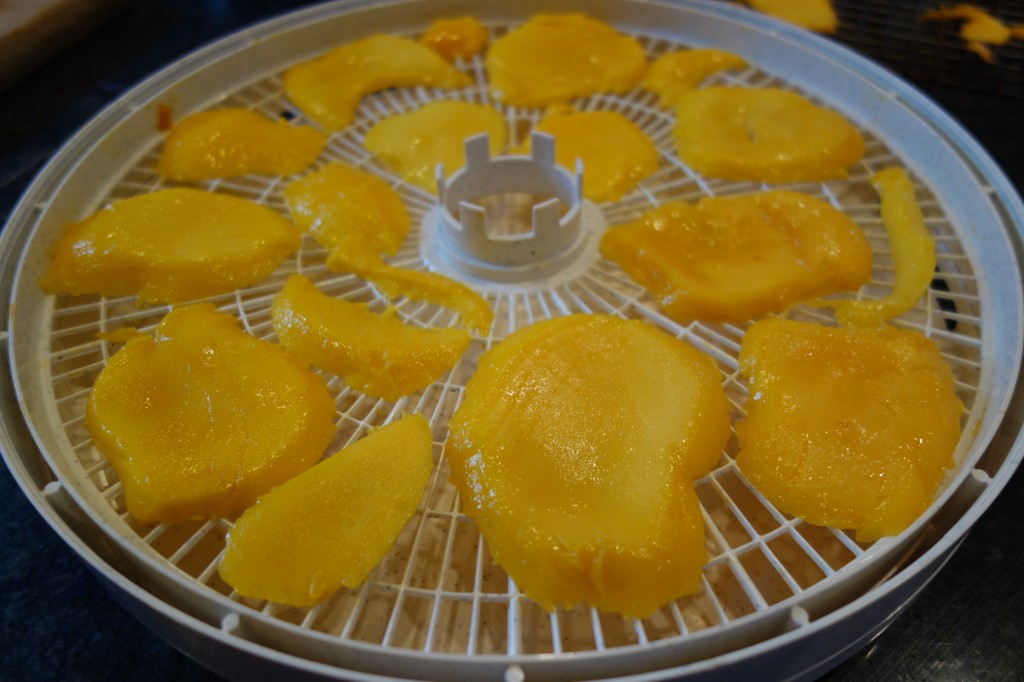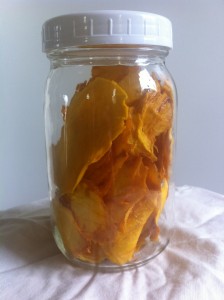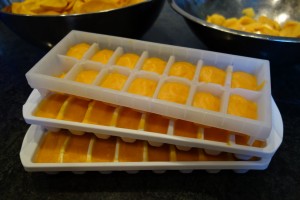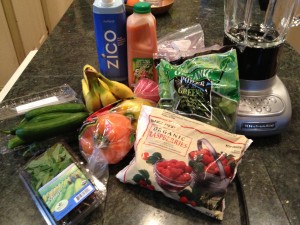Eat It Dirty
Two words: gut flora.
A pair of articles that appeared recently in the New York Times provide some good leads on why our reactions to food may be changing, why people eating the same diet today may be reacting to it differently than people did 40 years ago.
 First, Michael Pollan’s latest piece in the New York Times Magazine, Some of My Best Friends Are Germs, dives into the hidden world inside us and on us: the 100’s of trillions of bacteria that inhabit our gut, our skin and everywhere in between.
First, Michael Pollan’s latest piece in the New York Times Magazine, Some of My Best Friends Are Germs, dives into the hidden world inside us and on us: the 100’s of trillions of bacteria that inhabit our gut, our skin and everywhere in between.
I won’t do it justice, but I’ll give it a shot anyway: our bodies are chock full of microbes. In fact, for every one human cell in your body, there are about 10 non-human microbes. Many of these microbes have co-evolved with us, and play important roles in our health.
Small example:
We’ve known for a few years that obese mice transplanted with the intestinal community of lean mice lose weight and vice versa. (We don’t know why.) A similar experiment was performed recently on humans by researchers in the Netherlands: when the contents of a lean donor’s microbiota were transferred to the guts of male patients with metabolic syndrome, the researchers found striking improvements in the recipients’ sensitivity to insulin, an important marker for metabolic health. Somehow, the gut microbes were influencing the patients’ metabolisms.
And also:
Most of the microbes that make up a baby’s gut community are acquired during birth — a microbially rich and messy process that exposes the baby to a whole suite of maternal microbes. Babies born by Caesarean, however, a comparatively sterile procedure, do not acquire their mother’s vaginal and intestinal microbes at birth. Their initial gut communities more closely resemble that of their mother’s (and father’s) skin, which is less than ideal and may account for higher rates of allergy, asthma and autoimmune problems in C-section babies: not having been seeded with the optimal assortment of microbes at birth, their immune systems may fail to develop properly.
Much research has gone into one microbe in particular, Helicobacter pyolori (H. Pylori):
The microbe engages with the immune system, quieting the inflammatory response in ways that serve its own interests — to be left in peace — as well as our own. This calming effect on the immune system may explain why populations that still harbor H. pylori are less prone to allergy and asthma. Blaser’s lab has also found evidence that H. pylori plays an important role in human metabolism by regulating levels of the appetite hormone ghrelin. “When the stomach is empty, it produces a lot of ghrelin, the chemical signal to the brain to eat,” Blaser says. “Then, when it has had enough, the stomach shuts down ghrelin production, and the host feels satiated.” He says the disappearance of H. pylori may be contributing to obesity by muting these signals.
And H. pylori is nearly extinct in the Western gut.
So the various organisms that live in us and on us help us digest our food, help teach our immune system which microbes are friend and which are foe and perform other key functions in helping us live the way we evolved to.
So, what’s changed?
Well, there’s the obvious: “Children in the West receive, on average, between 10 and 20 courses of antibiotics before they turn 18,” according to Pollan. Each of those treatments carpet bombs the gut, ridding it indiscriminately of both beneficial and dangerous colonies of microbes. Some colonies bounce back, others don’t.
Of course, prescribed antibiotics taken directly are only part of the problem: all non-organically raised farm animals in the United States receive low doses of antibiotics their whole lives (see this Michael Pollan interview for why that is), so if you’ve eaten meat, you’ve been taking low doses of antibiotics every day of your life, further stressing your internal ecosystem.
But Pollan brings up a whole other set of influencers: the care and feeding of your microcolonies. The bacteria in your body need particular nutrients to thrive, as well. This starts early:
For years, nutrition scientists were confounded by the presence in human breast milk of certain complex carbohydrates, called oligosaccharides, which the human infant lacks the enzymes necessary to digest. Evolutionary theory argues that every component of mother’s milk should have some value to the developing baby or natural selection would have long ago discarded it as a waste of the mother’s precious resources.
It turns out the oligosaccharides are there to nourish not the baby but one particular gut bacterium called Bifidobacterium infantis, which is uniquely well-suited to break down and make use of the specific oligosaccharides present in mother’s milk. When all goes well, the bifidobacteria proliferate and dominate, helping to keep the infant healthy by crowding out less savory microbial characters before they can become established and, perhaps most important, by nurturing the integrity of the epithelium — the lining of the intestines, which plays a critical role in protecting us from infection and inflammation.
Which brings up the second article, Breeding the Nutrition Out of Our Food, which shows how the foods that we eat, even the whole food produce, has become gradually less nutritious over time, as we’ve bred it for flavor and sweetness.
Phytonutrients are a set of compounds produced in plants that have generally positive health effects for humans: they’ve been shown to reduce the risk of cancer, cardiovascular disease, diabetes and dementia, to name a few.
And they’ve been disappearing from our foods.
While I’d love to use this data to slap my GMO-loving friends in the face, the truth is it goes back much further than the 20th century. Since the beginning of agriculture, we’ve been selectively breeding our produce for sweetness and taste over the presence of phytonutrients (which often come with bitterness). Wild dandelions, for example, have seven times more phytonutrients than spinach. Purple potates have 28 times the cancer-fighting anthocyanin than russet potatoes. The ancestors of apples have a 100 times the phytonutrient content as most modern apples.
But we’ve certainly accelerated the trend: the sweet, juicy corn that we eat today simply didn’t exist a mere 200 years ago. Iceberg lettuce has about 1/5th the phytonutrients as spinach. The attractive orange variety of carrot that is the only kind available in most supermarkets has 1/7th the phytonutrients as their purple/orange cousins and less than 1/15th as much as their purple/yellow cousins.
So the food that we feed ourselves has been changing, and the food that we feed the microbial ecosystem that helps us digest our food has changed. Are you surprised that our reactions to food have changed?
So what are we supposed to do with all this? Here’s my take-away:
- Unless you’re a doctor scrubbing in, ditch the anti-bacterial soap and the bleach on everything. Let it grow.
- Consider giving your natural immune system a chance to deal with infections before resorting to antibiotics.
- Look for heirloom and wild varieties of fruits and vegetables.
- Eat root vegetables with the skin on: the skin is where most of the nutrients and microbiota are.
- Seek out fermented foods: kombucha, kimchi and raw-milk cheese, to name a few. They’re alive!
And there was one more passage from Pollan’s article that stuck out for me:
The data helped demonstrate that the microbial communities of couples sharing a house are similar, suggesting the importance of the environment in shaping an individual’s microbiome. Knight also found that the presence of a family dog tended to blend everyone’s skin communities, probably via licking and petting.
So, just as vaginal birth can help pass microbiota from mother to child, establishing a healthy ecosystem, the family dog licking everyone’s hands helps spread the beneficial microbiota from person to person within a household.
Don’t have a dog? Kiss your baby!
Coconut Milk Yogurt
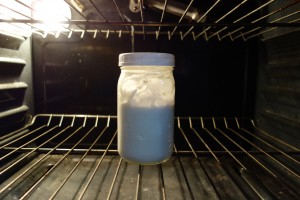 We used eat yogurt by the bucketful. Literally. A four pound container would last about week in our house.
We used eat yogurt by the bucketful. Literally. A four pound container would last about week in our house.
Zevin could eat his weight in yogurt (not literally). We used to feed him tons (again, not literally) partly because he loved it and partly because it seemed like such a wholesome food choice. The yogurt we gave him was full of healthy probiotics, after all, and Zevin’s gut needed all the help it could get.
Turned out, that Zevin is allergic to dairy. Oh, sad boy! He loved (loves) yogurt.
For a while he forgot about yogurt, but his preschool offers it as one of their family style snacks and Zevin’s started asking for it again. I stock a snack stash at school for days when he can’t eat what the school provides. I used to try to match it so if they served regular crackers, Zevin could have his allergen-free crackers; if they had regular cereal with milkm Zevin could have allergen-free cereal and non-dairy milk. But yogurt, well, I just couldn’t match that one.
We tried a few non-dairy substitutes, but none were particularly great in taste or texture, and every single non-dairy yogurt contained gums of some sort and most have added sugar. I might’ve occasionally bent my rules about whole ingredients and no added sugar so that Zevin could enjoy a yogurt at school on days that they served yogurt, but guar and xanthan can both be derived from corn. And yep, he’s allergic to corn.
Arrgh, what to do? My son is such a good sport about his food allergies, but this yogurt thing was getting him down.
I thought about coconut milk yogurt but we eat so much coconut already – coconut flour, dried coconut and coconut milk – that I wanted to go a different route. And I wanted protein in the yogurt. Nut milks are often used for dairy-free yogurt, but Zevin’s preschool is nut-free so nuts were out. Then I wondered about seeds. I have substituted sunflower seed butter (sunbutter) for nut butter in recipes before. Perhaps seeds would work.
After hours (days!) of research I discovered that most seeds lack the fat content necessary for making yogurt. I did find a single recipe for making sunflower yogurt out of homemade sunflower seed milk, but after three unsuccessful attempts resulting in watery (though tasty) yogurt, I abandoned the recipe.
So back to coconut milk yogurt. It doesn’t rate high for protein, but it does have healthy fats and, as a fermented food, it offers wonderful probiotics. Best of all, Zevin can sit elbow to elbow with his friends at the snack table enjoying (almost) the same thing.
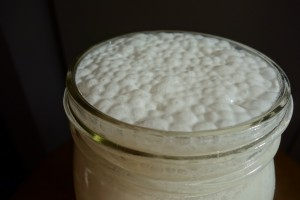 To make sure I wasn’t going to kill anyone with this yogurt, I consulted Cultures For Health. They have a nifty table with easy, straight forward, step-by-step instructions for making yogurt. I followed the last column, ‘Direct-Set Starter with Alternative Milk’, but skipped the part about heating the milk. I know we’ll likely drizzle a little honey or serve the yogurt with fruit, so I didn’t add sugar. We like tangy yogurt so I waited 24 hours before taking mine out of the oven.
To make sure I wasn’t going to kill anyone with this yogurt, I consulted Cultures For Health. They have a nifty table with easy, straight forward, step-by-step instructions for making yogurt. I followed the last column, ‘Direct-Set Starter with Alternative Milk’, but skipped the part about heating the milk. I know we’ll likely drizzle a little honey or serve the yogurt with fruit, so I didn’t add sugar. We like tangy yogurt so I waited 24 hours before taking mine out of the oven.
After the fermentation was done, I opened the lid and stirred the milk, which had separated. It bubbled up to the top of the jar and eventually settled back down. I put the lid back on and placed it in the fridge to thicken up. The next day I gave it a taste test and was pleased with the taste. The coconut milk that I used isn’t 100 percent creamy; it’s got small pieces of coconut in it, but we’re ok with that.
The yogurt got two thumbs up from Zevin. He asked for it to be less tangy next time, but that’s an easy fix. I think I’ll add vanilla to the rest of the batch, too, just to round out the flavors. His first bowl was drizzled with honey and happily gobbled up in minutes. Next Monday, yogurt is on the school’s snack calendar, and guess who’s going to be joining the the table? That’s right, a very happy boy.
Some notes before making this ridiculously easy, 2-ingredient yogurt.
- The only BPA-free can of organic coconut milk free of gums that I’ve found is Natural Value
. If you don’t mind gums but do want organic & BPA-free, try Native Forest
.
- Use whole fat coconut milk.
- Refrigerate the can overnight to allow the cream to thicken & the water to settle at the bottom. Keep the can upright & don’t shake it before opening. Scoop the thick stuff off the top, use the water for something else (a smoothie, perhaps).
- Use a capsule of high quality probiotics or inner-ēco dairy-free probiotic (it’s a liquid).
RECIPE
- 2 cans coconut milk, full fat
- 2 probiotic capsules or 2 T liquid probiotic
- Glass jar with lid, sterilized (running through the dishwasher is fine)
DIRECTIONS
- Scoop the thick coconut milk into the jar, add probiotic, stir, close lid.
- Let sit for 24 hours in an oven with the light on (don’t turn the oven on!). Your yogurt requires a somewhat constant 108 – 11o degrees to do its thing.
- Another option is to put a heating pad on low inside of a cooler, wrap the jar in a kitchen towel (something thin verses a thick bath towel) and set the jar in the cooler. Close the cooler & let sit for 8 – 24 hours.
- When yogurt reaches desired tang, place in refrigerator for at least 6 hours.
Autistic for a Day
People often remark how articulate and clear-spoken our four-year-old son Zevin is. So, when just moments after the doctor pricked his skin with the needle, Zevin became a different person, clapping and flapping his hands as he tried to explain something, and making a high-pitched “eeeee” noise, it was both startling and disturbing. Normally a remarkably coordinated four-year-old, he began bumping into tables as he stumbled around the room. His cheeks and ears flushed and his lips became bright red.
And while this autistic-like symptoms were exaggerated and (thankfully) temporary, it was easy to see that this was a compressed version of behaviors we’d seen in varying spells in him before: the tense, aggressive energy, a whole different animal than the cheerful boyish tumult we welcomed.
We were in the allergists office at Northwest Center for Environmental Medicine, following up on a hunch that Zevin had more than just gluten intolerance. This was the second of three allergy tests for the day, but the most striking. The first was for soy, this second one for corn, and eggs was yet to come.
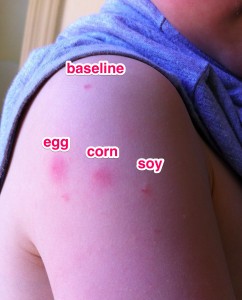 The morning long test began with a base-line pinprick: a tiny shot of glycerin in his upper shoulder, the control dose to ensure that any reactions we saw were not just due to needles or some other aspect of the test. Then came a dose of the allergen, followed by a ten minute observation of his behavior and skin reactions (at right), then another reduced dose of the allergen and more observation, and the cycle was repeated until the “no reaction” dose was reached.
The morning long test began with a base-line pinprick: a tiny shot of glycerin in his upper shoulder, the control dose to ensure that any reactions we saw were not just due to needles or some other aspect of the test. Then came a dose of the allergen, followed by a ten minute observation of his behavior and skin reactions (at right), then another reduced dose of the allergen and more observation, and the cycle was repeated until the “no reaction” dose was reached.
His reaction to corn wasn’t a complete surprise: we’d already noticed that following meals with corn-based ingredients, he seemed to act wilder, obstinate and harder to reason with. We suspected it was corn, but it was so hard to tell because corn and corn derivates are ubiquitous in the American diet: 40% of all packaged goods contain corn derivates. As Michael Pollan puts it: if you are what you eat, most of us are corn.
More surprising was his reaction to eggs, which I’d personally been pushing on him as “the perfect protein”: he became limp, quiet and withdrawn, draping himself over Michelle. It would have been easy to believe he was just worn out from his corn-fed frenzy, but we knew him well enough to know that even an hour of frenzy wasn’t enough to wear him out this much.
Thankfully, the symptoms from the tests subsided, and we settled back at home to start planning next steps: a restricted diet and a course of desensitization (see The Allergy Buster in the New York Times) that would hopefully allow Zev to return to normal eating soon.
But as we ran over the clues we’d had over the years that some food allergy might be impacting Zev’s behavior and development, we kept coming back to an awful thought: what about all the kids who suffered from similar allergies whose parents didn’t know?
Imagine that your child has behavioral issues: maybe they’re acting out or maybe they’re withdrawn, maybe missing development milestones, having trouble with speech or aggression, or seem to be overly sensitive to stimulus and noise. Maybe you chalk it up to “that’s just the way my kid is”.
But maybe it isn’t. Maybe the food you’ve been eating yourself, day after day while you nursed, and then the food you’ve served for breakfast lunch and dinner, is causing a reaction in their body, in their brain, that is changing their behavior and development from what it “should be” to what “it is”.
The numbers of children diagnosed with autism, ADHD and food allergies have all been skyrocketing (see Diagnoses of Autism on the Rise, ADHD Seen in 11% of US Children, Food Allergies Among US Children). Some people think it’s just better (or overaggressive) diagnostic techniques, others think something has changed in our environment or food pipeline, or maybe some epigenetic shift caused by who knows what. It’s easy to see, though, how a persistent, system-wide allergic reaction in the body, or anything that changes how key nutrients are absorbed, could impact the brain development of a growing child.
 The symptoms Zev was experiencing in that doctor’s office were a mixture of what would ordinarily be classified as autism or as ADHD: flapping hands, sub-par motor control, difficulty in focusing, fits of irrational anger. His experience there was sudden and stark, because of the dose and the subcutaneous way it was administered, but a child with a similar allergy who ingested the allergen (corn, in this case), day in and day out, would experience a low-grade version of these symptoms all the time. Without the contrast to “normal” behavior, it would be easy to assume that that’s simply “the way my child is” and ignored.
The symptoms Zev was experiencing in that doctor’s office were a mixture of what would ordinarily be classified as autism or as ADHD: flapping hands, sub-par motor control, difficulty in focusing, fits of irrational anger. His experience there was sudden and stark, because of the dose and the subcutaneous way it was administered, but a child with a similar allergy who ingested the allergen (corn, in this case), day in and day out, would experience a low-grade version of these symptoms all the time. Without the contrast to “normal” behavior, it would be easy to assume that that’s simply “the way my child is” and ignored.
Or maybe worse, assume he had a disorder, and medicate him.
In the short week since the test, and since we eliminated corn, soy and egg from his diet, we’ve already seen a calmer, more thoughtful, well-reasoned child (except when he’s tired, he is a four-year-old, after all). It’s been hard, but weighed against a lifetime of the alternative, we know it’s been worth whatever we have to do.
But we grieve for all the kids out there who may be on a path to special ed classes, medication or just tense, angry relationships with their frustrated parents.
What’s been most amazing is the number of people who seem to know that food allergies might be at the root of their children’s behavioral issues, but are unwilling to find out more, or to do something about it.
“I just couldn’t do it, it’s too hard to totally change the way we eat,” we hear, over and over.
I get it. Honestly, if it weren’t for Michelle, I wouldn’t be able to do it either. I’m not “doing it”. I only eat well, and Zevin only eats well, because she does the hard work to make it easy. And I’m grateful for that.
Sometimes I wonder: what if a doctor in a white lab coat told people that there was this medicine their child could take, and it would cure their kid’s ADHD or autism, and the medicine was delivered in this special food, but it was important for the medicine to work, that they not eat anything except the special food. Would people do it?
Of course, the ‘medicine’ is just good, wholesome food, without corn or gluten or dairy or whatever the kid was allergic to.
But maybe the key to that story is the doctor “giving them the medicine”. Most people don’t know where to start when it comes to remodeling their diet. I hope that’s what Michelle’s work (and workshop) will help address. If it can help even one more child live a different, better life than he would have, it’s well worth it.
[5/10/2013: I should clarify, since it may have been ambiguous, that Zevin does NOT have autism or ADHD, not even a little bit. He does has food allergies that we’ve been carefully studying and addressing. What I was hoping to convey is that based on his reactions to foods, it might have been mistaken for something larger, and, if left unaddressed, could possibly have led to something more permanent. And I hope that no child with a similar make-up is given a mistaken diagnosis.]
More with Mangos
The golden flood of spring mangos is still in full force and we’ve been taking advantage of this bounty. We’re eating lots of them fresh, saving most of the dried and pureed ones for later when fresh ones are no longer available.
Two nights ago I made a fresh mango salsa. Mango goes great with most meats, and since I’d already slow roasted a chicken earlier in the week, I wanted to use the leftovers.
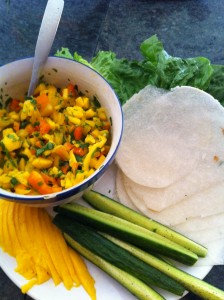 Salsa and chicken? Sounds like tacos! Since I can’t eat grains, Zevin’s allergic to corn and we steer clear of processed foods, we usually just skip taco shells and go the route of the lettuce wrap. Lettuce wraps work great for hand held food and I’m usually quite content with them. With tacos, though, I wanted something closer to a traditional taco shell. I wanted something more firm in my hand and little crunch for when my teeth first bite in.
Salsa and chicken? Sounds like tacos! Since I can’t eat grains, Zevin’s allergic to corn and we steer clear of processed foods, we usually just skip taco shells and go the route of the lettuce wrap. Lettuce wraps work great for hand held food and I’m usually quite content with them. With tacos, though, I wanted something closer to a traditional taco shell. I wanted something more firm in my hand and little crunch for when my teeth first bite in.
A while back I came across a photo of jicama standing in for a taco shell. I don’t know who came up with the idea, but it was brilliant. Jicama is quite pliable when sliced uber thin, and it provides the bite and crunch reminiscent of a traditional taco shell. Jicama make the perfect spring taco shell because they’re light and even a bit juicy. Their slightly earthy flavor melds well with fresh spring veggies and fruit. Yes, including mango!
The salsa is quick to put together and the jicama takes only a few minutes to slice on the mandolin. You can cook some chicken from scratch, use leftovers or pick up a roasted bird from your local market to keep things fast and easy. A quick and easy meal bursting with flavor and crunch.
[bigoven-recipe url=”http://www.bigoven.com/recipe/498891/chicken-mango-tacos”]
Mango Mania
 Mangoes are marvelous. A juicy sweetness like nothing else. They’re great plain or with a squeeze of fresh lime and a light sprinkle of cumin. Smoothies turn velvety with cubes of frozen mango blended in and have you ever had a mango lassi? Wow, the coconut milk-mango combo is such a treat! Mangoes also are great as the base for chutneys and salsas. Fresh, frozen or dried, hot or cold, mangoes are amazing.
Mangoes are marvelous. A juicy sweetness like nothing else. They’re great plain or with a squeeze of fresh lime and a light sprinkle of cumin. Smoothies turn velvety with cubes of frozen mango blended in and have you ever had a mango lassi? Wow, the coconut milk-mango combo is such a treat! Mangoes also are great as the base for chutneys and salsas. Fresh, frozen or dried, hot or cold, mangoes are amazing.
Our favorite kind is the small champagne, sometimes called ataulfo or honey, mango. They’re not stringy like their larger cousins are. The skin turns a golden yellow when ripe and inside is a brilliant orange-golden flesh with a thin, but large seed. And they are delicious. Incredible, really.
Available only twice a year, spring and summer, they’ve been for sale here in Seattle recently. We do love them, but they’re pretty expensive. Recently, though the sale was so awesome that I decided to stock up; we bought six cases of 12.
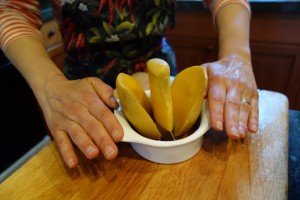 But fresh mangoes don’t last very long, so what do to do? Eat them, dehydrate some, eat some, puree some, eat some, freeze some, eat some more.
But fresh mangoes don’t last very long, so what do to do? Eat them, dehydrate some, eat some, puree some, eat some, freeze some, eat some more.
I set up an assembly (disassembly?) line to tackle the job. I rinsed them, sliced & pitted them, and scooped out the flesh. The choicest pieces were then sliced thinner to become dried mango. Anything slightly mushy or scraggly would be pureed, with the puree destined for fruit leather and mango ice cubes.
To make fast work of opening mangoes I rely on my trusty mango splitter, a gift from my mother-in-law a few years back. That slicer changed the way we look at mangoes in this house. I used to avoid buying them regardless of their succulent flesh because the seeds can be a beast to remove. Then came the magical mango slicer, and we’ve been enjoying copious fresh mango ever since.
This was the first time I’d dehydrated mango, and now I’m hooked. We used the Nesco FD-60 Snackmaster Food Dehydrator, and not only is ours so much less expensive than store bought, it’s far superior. The slices are dried but not at all dry or tough. They retain a slight, but easy chew and the flavor is much more intense than the dried mango we buy bought.
After pureeing I poured some of the mango into ice cubes trays, froze them, then popped them out and stored them in ziplock bags in the freezer. These were a hit, too: they add a delicious punch to Jordan’s morning smoothies or can be sucked on like little popsicles. Eating the cubes is yummy, but slippery!
The rest of the puree was dehydrated and, though it made decent fruit leather, wasn’t our favorite of the three preparations. Flavor-wise it’s great, but it’s a bit tough and gummy on the teeth. This was also my first foray into fruit leather dehydration, so maybe next time will be better.
And there will be a next time. It’s incredibly gratifying to prepare food for later knowing that I saved some moolah in the process. And the outcomes were so deliciously satisfying that I’m sure by the time fall rolls around, and the stores fill with mangoes again, our stash will be long gone and we’ll be eager for more.
Juice Brawl
 The Juice Bar Brawl, a New York Times article on the new juice bar craze that’s taken root in New York and LA, caught my eye, partly because it’s clear the entire industry has taken note of (but missed the core point of) my Drink My Salad article.
The Juice Bar Brawl, a New York Times article on the new juice bar craze that’s taken root in New York and LA, caught my eye, partly because it’s clear the entire industry has taken note of (but missed the core point of) my Drink My Salad article.
As you may remember, my recommendation for those, like me, too lazy to actually sit and, you know, eat vegetables, was to try throwing them in a blender with a bit of carrot juice and coconut water (for liquidity) as well as raspberries and mint (for sweetness and zing).
Apparently, the LA / NY scene is on to the same idea:
Half a decade ago, most people who were found guzzling and gushing about juice — not grocery store O.J., but the dense, cold-pressed stuff that is made by pulverizing mounds of ingredients like kale, beets, ginger, spinach and kohlrabi — were either zealots from the raw-food fringe or Hollywood celebrities who believed that a “juice cleanse” would nudge their toned bodies even closer to radiant perfection.
But along the way, more people started drinking it. And for consumers and entrepreneurs, a realization took hold: juice did not have to be part of a challenging, expensive cleanse. It could simply be lunch. Suddenly, cold-pressed juice morphed from a curiosity to an industry.
But wait! Not so fast! There’s a big difference between eating the whole, blended vegetable, and just drinking its juice: the fiber!
When you juice a vegetable, you leave the fiber behind. But the fiber is a key component in modulating the way your body absorbs sugars. If you extract just the sweet juice from vegetables and leave the fiber behind, you end up with a sugar rush: the same kind of thing you get from drinking a soda. Rapid fluctuations in blood sugar has been tied to a variety of health ailments, including Type 2 Diabetes. Fiber also lowers bad LDL cholesterol, promotes heart health and gives you the feeling of satiety that helps keep your mind away from unnecessary snacking.
And don’t even start talking Jamba Juice, which adds corn syrup to their “smoothies”, unless you really want to get me started.
When Michelle talks about “whole foods”, it’s usually set in contrast to “processed foods”. But here, it also means: “the WHOLE food”, as in, eat the whole thing, rather than strip-mining just the sweet parts you like.
It’s Gluten Free, but is it Healthy?
I never regret not eating gluten: I felt so bad before that it’s just a no-brainer now. I’ve accidentally eaten it and then suffered terrible reminders of what it does to me, but since I cut it from my diet a few years ago, I’ve never intentionally eaten it.
And that worked for a while. Like a sort of secular “removal of chametz“, I cleared the house of gluten and went shopping for gluten-free goodies. The taste and texture of gluten-free foods required an adjustment, but after a while of having no baked goods, no breads – well, just about anything was worth trying. So with some taste tests and a then few things immediately ditched, I found many gluten free foods to replace what was now verboten. Cereals, crackers, cookies, pasta, boxed and frozen foods. And as time passed, more and more things became available at the grocery store.
The quality of gluten free food improved, too. We tried them all and increased our pantry inventory. We ate gluten free waffles, gluten free muffins and gluten free cereal for breakfast. Mid-morning snacks for my (then) toddler and I usually included gluten free crackers or gluten free granola bars. Lunch often found itself on gluten free bread with some gluten free chips on the side. Gluten free pasta would find its way onto our dinner menu at least twice a week along with gluten free burger buns and gluten free pizza. Gluten free treats were never in short supply, either, whether whipped up from a mix or eaten straight from a box.
We even dined out with more frequency as local restaurants jumped on the gluten free train. Plenty of gluten free buns and pastas were offered on menus alongside fries and onion rings prepared in safe, dedicated fryers. Eating gluten free became easier and tastier by the day.
That is, until the day that I realized that I no longer felt great.
I started questioning my diet and looked at what I was really eating. It was all gluten free, most of it was even organic, but it was highly processed. One of the cornerstones of eating healthy is variety, but after reading several packages one thing was clear – they all had the same basic ingredients, and those ingredients weren’t particularly healthy, either: rice flour, potato starch, xanthan gum, and sugar in some form or another topped the list. None of those provides much nutrition and practically zero dietary fiber.
These gluten free treasures were full of processed starches and white sugar. Are they safe for someone on a gluten free diet? Sure. Are they healthy? Most often, no. And, to add insult to injury many aren’t even fortified the way other processed food is so they’re utterly lacking in vitamins. Processed foods have the good stuff processed right out of them so the FDA requires that nutrients be put back in. However, gluten free foods are not required to be fortified.
What would make me feel better? What is our bodies need to fuel themselves? Our bodies need nutrient-dense, healthy foods. Many of modern health ailments didn’t exist before processed food, or at least not in the numbers that they appear today. So if we were healthier before we started putting food in boxes, what did that food look like? It was unprocessed . These foods are called whole foods because they’re basically unchanged from how they grew or lived. I guarantee that you won’t find crunchy, airy cheese puffs growing in a field or vines of multi-colored licorice draped in trees (except perhaps, in the factory at right). And if you eat meat, it probably didn’t grow with nitrites or fillers.
. These foods are called whole foods because they’re basically unchanged from how they grew or lived. I guarantee that you won’t find crunchy, airy cheese puffs growing in a field or vines of multi-colored licorice draped in trees (except perhaps, in the factory at right). And if you eat meat, it probably didn’t grow with nitrites or fillers.
So I did another pantry overhaul. I knew that a healthy diet was based on whole foods – foods that have no processing, that look like they did when they grew or walked or flew. I’d plan meals around vegetables, meats, nuts, seeds, and fruit. I even changed the fats we use – no more processed oils like canola or grape seed. Instead we’d use butter, olive oil and coconut oil. Anything that came in a package was scrutinized – was the ingredient list made of real food? Were they whole foods? I allowed for nut flours and coconut flour because they’re basically a whole food, they’re just ground up. Nothing was chemically altered, no ingredients added to make the product. Same thing with nut butters. I even found some crackers and packaged snacks that met this criteria.
I kept a few packaged products like gluten free pasta, rice crackers and truly wholesome granola because I knew that I’d occasionally need a few quick-fix solutions, especially until I got this new whole foods eating plan working for our family. Our pantry was now pared down considerably and our fridge and freezer more filled with meats and produce. At first I spent a lot of time in the kitchen prepping and cooking but as time went on I developed strategies to minimize my kitchen time and still turn out healthy, tasty meals. It’s certainly more work than ripping open a box and adding water, but not much and we all feel great and that’s worth all the time in the world, if need be.
If completely overhauling your pantry seems daunting, here are three high-impact things you can do to reduce your reliance on processed foods:
- Cut up several days worth of carrots, peppers or other crunchy vegetables in advance, then store them in a clear jar in your fridge. Grab these when you when you want something to munch on.
- Instead of the toast that goes with your plate of eggs in the morning, try putting your egg on a bowl of quinoa or even oatmeal. Sprinkle a little salt and drizzle a little honey for a sweet-and-savory and satisfying breakfast.
- A great substitute for sliced “lunch meats”: real meat. Grab a pre-roasted chicken from PCC or Whole Foods, then pull it off the bones for convenient snacking.
Hidden Gluten Ingredients
Shopping for gluten free has become much easier in recent years. Many packages promote their status with splashy labels of “GF” or even “certified gluten free”.
 But what about the packages that don’t have those handy words printed on them? Do you just read the ingredient list and look for the word ‘gluten’? Or maybe check to see if it says ‘wheat’? If you must avoid gluten, neither of those words is enough.
But what about the packages that don’t have those handy words printed on them? Do you just read the ingredient list and look for the word ‘gluten’? Or maybe check to see if it says ‘wheat’? If you must avoid gluten, neither of those words is enough.
Since gluten is found in barley, wheat and rye, those words are great starting points, but gluten is often hiding out in the ingredients list under other names. It’s hiding in there and your job is to identify it and avoid it.
Malt flavoring? It comes from barley, doh! Seiten? Sure, it’s vegetarian – but it’s got wheat!
Now here’s the really tricky stuff: these things don’t even sound like foods, much less like gluten. Hydrolyzed plant protein? It can be derived from a gluten-containing plant. Dextrin? Unless it’s labeled gluten free, it might come from wheat. Triticum vulgare germ extract? It’s basically wheat germ oil.
Other key words to be wary of include filler, coating, natural flavoring, natural coloring, binding, starch and stabilizer. These can all contain gluten, unless specifically labeled otherwise.
Foods that often seem fine at first glance, but are not upon closer inspection include soy sauce (but not tamari), teriyaki sauce, vegetable broths and bouillon.
There are a number of good lists online of “hidden gluten”, but I’ve found celiac.com to be one of the most extensive. They have an ‘unsafe ingredients’ list as well as a ‘safe ingredients’ list. I recommend bookmarking them on your smart phone so that you can call them up while you’re shopping. When I changed to a gluten free diet I relied on these lists until I became familiar with some of the more common terms.
Finally, note that although oats are inherently gluten free, sensitive individuals may experience trouble eating them. Cross-contamination with gluten during the growing, transporting, processing or packaging of oats can occur, so always look for the gluten free label if you buy oats. Also, people who can’t eat gluten frequently have problems with oats regardless of their gluten free status.
Passover 2013

Fortunatley, we found a very tasty “matza-like” alternative: Yehuda Gluten Free Matzo Style Squares. They’re tasty, a bit sweeter than their glutinous cousins, and just as difficult to break along the scoring. The matza, made from potato starch, is kosher, but not for “sacramental purposes”. Since we can’t have gluten, though, these work as a suitable replacement for our family.
Of course, our family has about 20 other foods on the “no” list, but I actually enjoy the challenge of creating a menu that will accommodate everyone’s diets and still be thoroughly enjoyable and memorable.
For a seder (the Passover ceremony and meal), there are a few traditional dishes that I use as my base, and then, keeping in mind what’s safe for all diners to eat, I make a menu.  This year we ate:
This year we ate:
- Matza & Charoset
- Deviled Eggs
- Matza Ball Soup (thank you, Elana’s Pantry for the matza ball recipe)
- Green Salad with Jordan’s Famous Dressing*
- Roasted Sweet Potato Strips
- Roasted Balsamic Asparagus
- Roasted Beets with Orange Zest
- Applesauce
- Brisket
Followed by
- Almond-Strawberry Mini Cupcakes (topped with coconut whipped cream)
- Chocolate Coconut Mini Cupcakes (topped with coconut whipped cream)
- Linzer-like Cookies (I substituted sugarless fruit jam for the date filling)
For the matza balls, Elana’s pantry recommends some specific almond flours that have a fine texture. We didn’t have those, so I substituted Bob’s Red Mill Almond Meal/Flour instead. The matza balls came out tasting very much like a “regular” matza ball, but with a slightly grittier texture, at least when they first touched the tongue. It wasn’t a bad sensation, just a little jarring when you’re expecting a fluffy soft matza ball like your bubbe used to make.
Yum, right? Keep in mind that this delicious menu contained only whole foods (with the exception of the matza, but, hey – you gotta have matza!), had no grains or refined sugar. Any of the recipes could work for a host of healthy diets – whole foods, gluten-free, and paleo. Most are suitable for both SCD or GAPS.
* Equal parts 1/2 c olive oil, 1/2 c balsamic vinegar, 3 healthy “splorches” (Jordan’s words) of stone ground mustard, one hefty spoonful of honey, in a blender.
Drink My Salad
I’m lazy. How lazy am I? I’m too lazy to chew.
Seriously, I enjoy a good salad: they taste great, they make me feel great, but OMG, they take so long to eat. Take a bite, chew, chew, chew. Take another bite, chew, chew, chew.
“Hey Jordan, we’re going out, wanna come?”
“Nope, sorry, I gotta stay home and masticate.”
Fortunately, I’ve found a solution: drink my salad. All the yumminess and healthy goodness of a salad, but you can slurp it down on the go!
Here’s my recipe. As noted, you should think of this as a starting point. Personalize it. One bonus of the ingredients that I use is that virtually all of them can be found at Trader Joe’s, making for an easy shopping trip. I’ll make a big batch, freeze some of it, drink it over several days, then leave my frozen jar in the fridge to defrost for the next day.
[bigoven-recipe url=”http://www.bigoven.com/recipe/476423/salad-smoothie”]
Note: this is a salad in a blender, not be be confused with the sugar syrup they sell at places like Jamba Juice.


